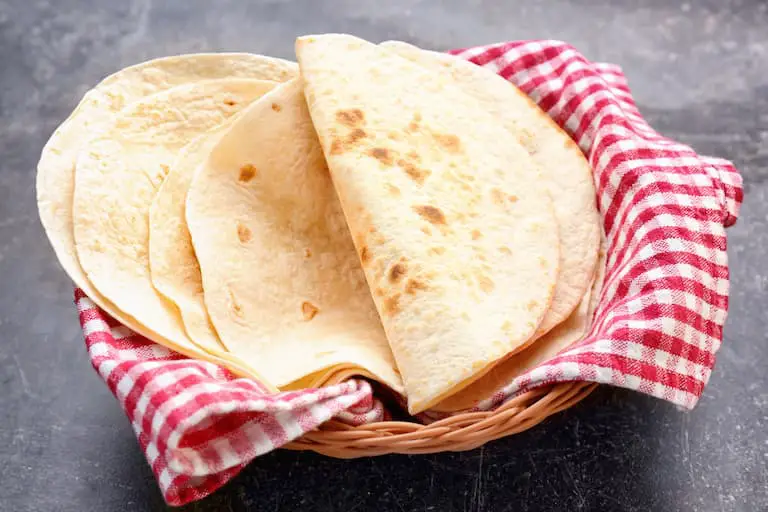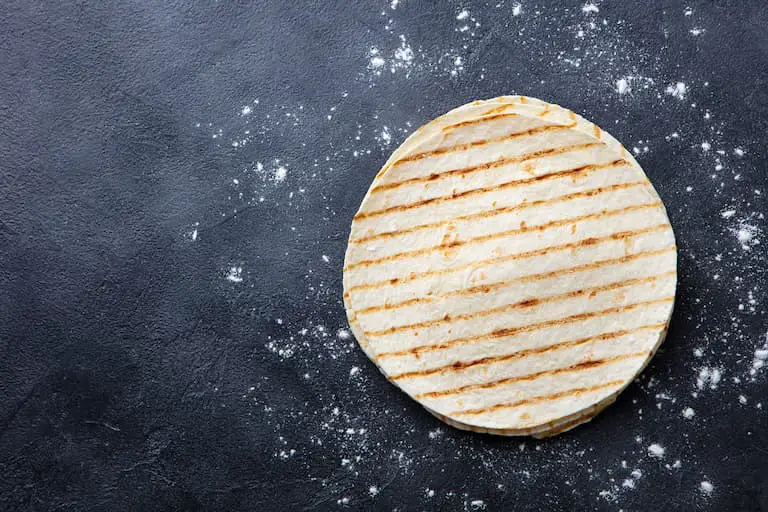How to Freeze Corn & Flour Tortillas (Homemade & Store Bought)
A tortilla is a Mexican staple enjoyed worldwide, and are perfect for taco night, lunch wraps, and pizza crusts. You do not want food this versatile to mold or go stale, so how do you save a corn or flour tortilla from going bad?
You can freeze tortillas by separating them with parchment paper or aluminum foil and sealing them in a plastic freezer bag for up to eight months to retain their freshness. Tortillas stored on the counter only last a few days, and refrigerated ones are suitable for roughly two weeks.
There is a way to freeze any tortilla, including flour or corn tortillas, tortilla dough, homemade warmed tortillas, and store-bought tortillas. Read on to learn more about the best ways to freeze your favorite corn or flour tortillas to save them for many months.

Freezing Homemade Tortillas vs. Store-Bought Tortillas
Homemade tortillas and store-bought tortillas generally can be frozen the same way. However, there are some nuances to be aware of when freezing both types of tortillas to retain the same taste and consistency.
How To Freeze Homemade Tortillas (Before and After Cooking)
Since fresh, homemade tortillas taste the best right off the skillet or flat top, you can freeze them before cooking once they’ve been pressed. You can store them in the freezer before heating to lock in their delicious flavor.
To freeze homemade, uncooked tortilla dough, press the dough into tortilla form and separate each tortilla with aluminum foil or parchment paper to ensure the tortillas do not stick together and seal inside a resealable freezer bag or fully cover the stack in plastic wrap.
Freeze 5-10 tortillas per bag. Storing your homemade tortillas in small stacks will allow you only to take out what you will use.
Alternatively, you can freeze or refreeze your homemade tortillas after heating them. You must, however, let them cool to room temperature before bagging them. Otherwise, moisture from the warm tortillas will remain in the freezer bag and cause freezer burn if you don’t allow them to cool first.
Homemade tortillas will save in the freezer for up to eight months but are best if used within 2-3 months. After eight months, the tortillas can become stiff, chewy, or develop freezer burn. Do not eat tortillas with mold or a funky smell, which means they have spoiled.

How To Freeze Store-Bought Tortillas
You can freeze unopened store-bought tortillas after you buy them if left in the sealed plastic you purchased as long as the package is not ripped or torn.
Open store-bought tortillas sealed in the original plastic packaging can also be frozen if the plastic is intact and has a resealable closure.
If you want your store-bought corn or flour tortillas to last as long as possible, however, it will be better if you remove them from the thin plastic bag they were purchased in and placed in a heavy-duty freezer bag. Use parchment paper or aluminum foil to separate each of the tortillas in order to avoid them sticking together.
Store-bought tortillas are generally made with preservatives and other ingredients to make them last longer and can typically be frozen for up to between 6 and 8 months.
Homemade tortillas that do not contain preservatives will have a shorter shelf life. Freezing both homemade and store-bought tortillas allows you to enjoy them longer without sacrificing flavor and texture.
Defrosting & Reheating Your Frozen Tortillas (4 Tips)
Freezing your tortillas is essential to lock in the fresh taste and consistency. But defrosting and reheating your tortillas is just as important so you can enjoy them at your next meal. Here are four defrosting and reheating tips for your corn, flour, homemade, and/or purchased tortillas.

Thaw Frozen Tortillas In the Refrigerator
Take your tortillas out of the freezer and place them in the fridge for 12 hours. Depending on how many tortillas you are thawing, the time it takes could be longer or shorter. Once the tortillas are soft and pliable, they are ready to be eaten.
Alternatively, you can leave the tortillas on the counter to warm to room temperature. Don’t, however, leave them out for an extended period in order to avoid bacteria growth. This is especially a concern for homemade tortillas without preservatives.
Use the Microwave Defrost Feature to Thaw Frozen Tortillas
Separate the corn or flour tortillas and wrap them individually in a damp paper towel. Use the “defrost” setting or low power mode and heat the tortillas for 15 seconds, one at a time.
Flip the tortillas over and defrost for 15 more seconds.
If the tortilla is not warm enough, heat for an additional 15 seconds on each side. Heating your tortillas longer than 60 seconds will cause the gluten to break down. Separated gluten will make your tortilla very chewy.
Bake Frozen Tortillas In the Oven
Preheat your oven to 350°F (176.6°C) and line a baking sheet with aluminum foil. Spread the tortillas on the baking sheet but do not stack or layer them because they will bake together and be difficult to take apart. Or you can put parchment paper between them.
Bake for 15-20 minutes.
Use a Stovetop Skillet to Reheat Frozen Tortillas
Using medium heat and no oil, place your tortilla directly on the stovetop or skillet. Heat for 20-30 seconds on each side. Or, if you’d like tortilla chips, try heating up a little oil in the skillet. Cut the tortillas into wedges and fry them in the hot oil until each side is golden and crispy.
Find Your Favorite Method
Try each technique to find your favorite way to reheat your frozen tortillas. You can also thaw the tortillas in the refrigerator in the morning and reheat them using the stove or skillet at dinner.
Heating times may vary if you choose to mix reheating instructions. Closely monitor your tortillas, so they do not overcook or burn. Overcooked tortillas become dry, stiff, and cracked. Unless you are making tortilla chips, you don’t want your tortillas to be this fragile.
A Brief History of the Tortilla
Natives of Mexico introduced the Spaniards to “lexicalli” in 1519, which is a flatbread made of maize. The product using maize kernels to make flatbreads was later named “tortilla,” meaning “little cake.”
Today, we know the Aztecs were the oldest known culture to have made a version of the tortilla dating back 10,000 years.
Traditionally, tortillas are made by hand using corn, or another grain such as flour, ground into maize and flattened, then cooked on a flat surface. Historically, pressing the maize was done by hand, but today, machines do a lot of the work.
Modern technology has allowed us to mass-produce tortillas quickly. Mass-producing is excellent for companies, but you should try a tortilla made the old-fashioned way if you have not yet had the opportunity.
Nothing compares to a warm homemade tortilla. Yum!
Types of Tortillas
Flour and corn are the most common store-bought tortillas. Both have their merits, but ultimately, your choice is based on taste and texture.
Flour tortillas are sturdier and are great for heartier dishes like burritos. Corn tortillas are commonly used for tortilla chips and tacos because they are stiffer and won’t crumble under the hefty weight of larger meals.
Corn tortillas are the healthier option according to the nutrition facts. A flour tortilla’s calories and fat double compared to corn tortillas. Take a look at this comparison:
- A 100-gram (3.52 oz) flour tortilla is about 300 calories and 8 grams (0.28 oz) of fat.
- Corn tortillas are around 150 calories and 2.5 grams (0.08 oz) of fat.
However, flour tortillas have double the protein at about 9 grams or 0.31 oz (corn tortillas have approximately 4.5 grams or 0.15 oz), while corn tortillas tend to be almost 80% higher in fiber, sugar-free, and naturally gluten-free.
You should avoid flour tortillas if you have gluten sensitivity or celiac disease.
Corn and flour tortillas come in a variety of sizes and flavors and are made from yellow, white, or blue corn kernels. Whichever type of corn you choose will change the taste and texture. You may find you like one over the other.
Flour tortillas usually contain white flour, but other options include wheat, gluten-free, and low-carb. Spinach tortillas are a popular choice to incorporate more flavor and nutrition into your wraps.
Mission Tortillas have a variety of flavors to choose from, but the first ingredient listed is flour, so it still fits in the category of “flour tortilla.” It may not be the best option for those who are gluten-intolerant. You should check the tortilla’s nutrition facts before purchasing to be sure they meet your dietary and sensitivity needs.
You can get creative when making your tortillas by using a different base, adding herbs and spices, and mixing and matching flavors.
For instance, El Rincon Mexican Kitchen has a unique menu, offering five tortilla options on their menu:
- Corn
- Flour
- Nepal (cacti)
- Spanish
- Beetroot
Nepal, or cactus pads, are delicious and full of fiber and don’t worry, they already took the needles out. Spanish tortillas are unique since they do not use a grain. Instead, they are made by mixing potatoes, eggs, onion, and salt.
The sky’s the limit when it comes to your imagination.
Conclusion
You can enjoy your flour or corn tortillas for up to eight months if kept in the freezer properly. Ideally, however, you will want to use your frozen tortillas within about three months. The best way to freeze your tortillas is to wrap them in an airtight or resealable freezer bag or freezer-safe plastic wrap.
If heated, ensure your tortillas cool to room temperature before freezing to avoid moisture from accumulating inside the sealed package. Thaw and reheat your tortillas in the refrigerator, microwave, oven, or stovetop.
This way you can enjoy your favorite tortillas for months!






